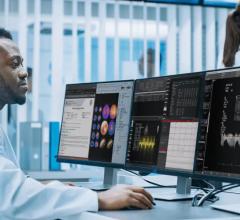
The Odyssey workstation
September 16, 2009 – Texas Cardiac Arrhythmia Institute at St. David’s Medical Center in Austin, Texas plans to create a worldwide electrophysiology (EP) telecardiology network for live consultations with other EP labs anywhere in the world using the Odyssey Network offered by Stereotaxis.
Stereotaxis Inc. said yesterday the institute ordered four Odyssey systems, the largest order to date for these systems. One will manage the institute’s Stereotaxis Niobe Remote Magnetic Navigation electrophysiology lab and the other three will manage its standard, non-Niobe EP labs. All four systems will utilize an Odyssey Cinema server to record synchronized procedure data and share this information via the Internet anywhere in the world.
Odyssey Cinema synchronizes the data from multiple interventional lab systems and includes a powerful archiving capability to instantly store and replay an integrated view of entire procedures or segments of procedures. The solution also allows physicians to collaborate with high-definition views of live or recorded procedures from multiple points in the network of installed Odyssey systems, providing a significant new tool for clinical collaboration, remote consultation, and educational training. There are currently more than 60 Odyssey systems ordered to date, according to Stereotaxis.
“Our vision is to use Odyssey to significantly accelerate the advancement of electrophysiology worldwide,” said Andrea Natale, M.D., FACC, FHRS, and executive medical director of the Texas Cardiac Arrhythmia Institute at St. David’s Medical Center. “With Odyssey, we have the technology to create unprecedented educational programs by sharing live cases over the network and by replaying best practices in interactive forums. Our connection to other centers on the Odyssey network will allow us to collaborate from Austin with other experts on a global basis without traveling. This creates a new standard for the practice of electrophysiology, unleashing new opportunities by allowing hospitals to have a powerful marketing tool and enabling patients on the Odyssey network to receive enhanced care around the world.”
The Texas Cardiac Arrhythmia Institute will utilize the Odyssey network to connect with specific facilities around the world. Deliveries of the Odyssey systems to manage the standard EP labs will begin in the fourth quarter.
Stereotaxis said Odyssey was developed to standardize data integration and management for all interventional labs and provide access to the live and recorded procedure information where and when it is needed. Through its proprietary data compression technology, the system enables sharing of this data with other interventional labs around the world via a secure Internet connection.
The Odyssey Workstation standardizes data integration for magnetic and standard interventional labs by enhancing the physician workflow through a consolidated display of multiple systems and eliminating the challenge of interacting simultaneously with many separate diagnostic systems. Odyssey Cinema then captures a complete record of synchronized procedure data that can be viewed live or from a comprehensive archive of cases performed. Through its proprietary data compression technology, the Odyssey enables the sharing of live and recorded procedure data via a laptop anywhere over a secure high speed Internet connection. Hospitals can also share procedures with other institutions using Odyssey Connect providing a forum for defining clinical best practices across a broad spectrum of medical procedures.
For more information: www.stereotaxis.com


 May 15, 2024
May 15, 2024 








